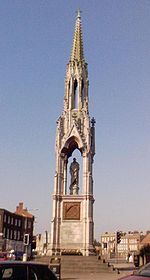
Clarkson Memorial
Encyclopedia

Wisbech
Wisbech is a market town, inland port and civil parish with a population of 20,200 in the Fens of Cambridgeshire. The tidal River Nene runs through the centre of the town and is spanned by two bridges...
, Cambridgeshire
Cambridgeshire
Cambridgeshire is a county in England, bordering Lincolnshire to the north, Norfolk to the northeast, Suffolk to the east, Essex and Hertfordshire to the south, and Bedfordshire and Northamptonshire to the west...
, England
England
England is a country that is part of the United Kingdom. It shares land borders with Scotland to the north and Wales to the west; the Irish Sea is to the north west, the Celtic Sea to the south west, with the North Sea to the east and the English Channel to the south separating it from continental...
commemorates Thomas Clarkson
Thomas Clarkson
Thomas Clarkson , was an English abolitionist, and a leading campaigner against the slave trade in the British Empire. He helped found The Society for Effecting the Abolition of the Slave Trade and helped achieve passage of the Slave Trade Act of 1807, which ended British trade in slaves...
(1760 – 1846), a central figure in the campaign against the slave trade
Atlantic slave trade
The Atlantic slave trade, also known as the trans-atlantic slave trade, refers to the trade in slaves that took place across the Atlantic ocean from the sixteenth through to the nineteenth centuries...
in the British empire
British Empire
The British Empire comprised the dominions, colonies, protectorates, mandates and other territories ruled or administered by the United Kingdom. It originated with the overseas colonies and trading posts established by England in the late 16th and early 17th centuries. At its height, it was the...
, and a former native of Wisbech.
The memorial consists of statue
Statue
A statue is a sculpture in the round representing a person or persons, an animal, an idea or an event, normally full-length, as opposed to a bust, and at least close to life-size, or larger...
mounted on a platform. Above this, rises a canopy, in the form of a spire
Spire
A spire is a tapering conical or pyramidal structure on the top of a building, particularly a church tower. Etymologically, the word is derived from the Old English word spir, meaning a sprout, shoot, or stalk of grass....
. The whole structure is 68 feet (20.6 m) high. On three of the four sides are carved bas-reliefs, representing William Wilberforce
William Wilberforce
William Wilberforce was a British politician, a philanthropist and a leader of the movement to abolish the slave trade. A native of Kingston upon Hull, Yorkshire, he began his political career in 1780, eventually becoming the independent Member of Parliament for Yorkshire...
and Granville Sharp
Granville Sharp
Granville Sharp was one of the first English campaigners for the abolition of the slave trade. He also involved himself in trying to correct other social injustices. Sharp formulated the plan to settle blacks in Sierra Leone, and founded the St. George's Bay Company, a forerunner of the Sierra...
, both prominent figures in the campaign against the slave trade, and a manacled slave
Slavery
Slavery is a system under which people are treated as property to be bought and sold, and are forced to work. Slaves can be held against their will from the time of their capture, purchase or birth, and deprived of the right to leave, to refuse to work, or to demand compensation...
in a beseeching attitude. The fourth side bears an inscription to the memory of Clarkson.
History
The Memorial is in Bridge Street, on the South Brink of the River NeneRiver Nene
The River Nene is a river in the east of England that rises from three sources in the county of Northamptonshire. The tidal river forms the border between Cambridgeshire and Norfolk for about . It is the tenth longest river in the United Kingdom, and is navigable for from Northampton to The...
. It is on the site of the old Customs House, built in 1801, which itself replaced the Butter Market. In 1856 the Old Bridge was rebuilt, and the Customs House pulled down to make way for the bridge improvements. In 1880, when work started on the Clarkson Memorial the location was chosen because of its central position.
The Clarkson Memorial cost £2,035, and was paid for primarily by a large donation from the Peckover family, local Quaker philanthropists. The shortfall was made up by public subscriptions. Work started on 28 October 1880 and the statue was unveiled on 11 November 1881.
The original design was an adaption of one by Sir George Gilbert Scott RA, who first put forward his design in 1875.
A four year renovation project was completed in 2011 and a new supplicant panel installed to coincide with the 130th anniversary of the building of the monument.
The monument is also used as the saluting point for the Remembrance Day parade.

